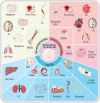Advances in the application of extracellular vesicles derived from three-dimensional culture of stem cells
- PMID: 38693585
- PMCID: PMC11064407
- DOI: 10.1186/s12951-024-02455-y
Advances in the application of extracellular vesicles derived from three-dimensional culture of stem cells
Abstract
Stem cells (SCs) have been used therapeutically for decades, yet their applications are limited by factors such as the risk of immune rejection and potential tumorigenicity. Extracellular vesicles (EVs), a key paracrine component of stem cell potency, overcome the drawbacks of stem cell applications as a cell-free therapeutic agent and play an important role in treating various diseases. However, EVs derived from two-dimensional (2D) planar culture of SCs have low yield and face challenges in large-scale production, which hinders the clinical translation of EVs. Three-dimensional (3D) culture, given its ability to more realistically simulate the in vivo environment, can not only expand SCs in large quantities, but also improve the yield and activity of EVs, changing the content of EVs and improving their therapeutic effects. In this review, we briefly describe the advantages of EVs and EV-related clinical applications, provide an overview of 3D cell culture, and finally focus on specific applications and future perspectives of EVs derived from 3D culture of different SCs.
Keywords: 3D cell culture; Clinical applications; Extracellular vesicles; Stem cells; Therapeutics.
© 2024. The Author(s).
Conflict of interest statement
The authors declare that they have no competing interests.
Figures






Similar articles
-
Four sides to the story: A proteomic comparison of liquid-phase and matrix-bound extracellular vesicles in 2D and 3D cell cultures.Proteomics. 2024 Sep;24(18):e2300375. doi: 10.1002/pmic.202300375. Epub 2024 Jan 10. Proteomics. 2024. PMID: 38197488
-
Enhanced extracellular vesicle production and ethanol-mediated vascularization bioactivity via a 3D-printed scaffold-perfusion bioreactor system.Acta Biomater. 2019 Sep 1;95:236-244. doi: 10.1016/j.actbio.2018.11.024. Epub 2018 Nov 22. Acta Biomater. 2019. PMID: 30471476 Free PMC article.
-
Stem cell- derived extracellular vesicles as new tools in regenerative medicine - Immunomodulatory role and future perspectives.Front Immunol. 2023 Jan 24;14:1120175. doi: 10.3389/fimmu.2023.1120175. eCollection 2023. Front Immunol. 2023. PMID: 36761725 Free PMC article. Review.
-
Therapeutic Advances of Stem Cell-Derived Extracellular Vesicles in Regenerative Medicine.Cells. 2020 Mar 13;9(3):707. doi: 10.3390/cells9030707. Cells. 2020. PMID: 32183102 Free PMC article. Review.
-
Effects of Hydrogels on Mesenchymal Stem/Stromal Cells Paracrine Activity and Extracellular Vesicles Production.J Extracell Vesicles. 2025 Mar;14(3):e70057. doi: 10.1002/jev2.70057. J Extracell Vesicles. 2025. PMID: 40091440 Free PMC article. Review.
Cited by
-
High-yield BMSC-derived exosomes by the 3D culture system to enhance the skin wound repair.Regen Biomater. 2025 Apr 10;12:rbaf022. doi: 10.1093/rb/rbaf022. eCollection 2025. Regen Biomater. 2025. PMID: 40309353 Free PMC article.
-
Optimizing mesenchymal stem cell extracellular vesicles for chronic wound healing: Bioengineering, standardization, and safety.Regen Ther. 2024 Jun 15;26:260-274. doi: 10.1016/j.reth.2024.06.001. eCollection 2024 Jun. Regen Ther. 2024. PMID: 38978963 Free PMC article. Review.
-
Therapeutic Approaches and Potential Mechanisms of Small Extracellular Vesicles in Treating Vascular Dementia.Cells. 2025 Mar 11;14(6):409. doi: 10.3390/cells14060409. Cells. 2025. PMID: 40136659 Free PMC article. Review.
References
Publication types
MeSH terms
Grants and funding
- 82303775/the National Natural Science Foundation of China
- 82172102/the National Natural Science Foundation of China
- BE2021689/the Jiangsu Province's Major Project in Research and Development
- Grant ss2018003/Zhenjiang Key Laboratory of High Technology Research on Exosomes Foundation and Transformation Application
LinkOut - more resources
Full Text Sources
Other Literature Sources
Medical

